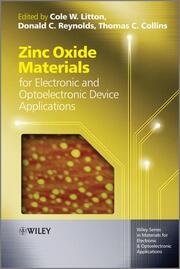Detailansicht
Zinc Oxide Materials for Electronic and Optoelectronic Device Applications
Wiley Series in Materials for Electronic & Optoelectronic Applications
ISBN/EAN: 9780470519714
Umbreit-Nr.: 1529218
Sprache:
Englisch
Umfang: 386 S.
Format in cm:
Einband:
gebundenes Buch
Erschienen am 24.03.2011
Auflage: 1/2011
- Zusatztext
- This book provides a complete coverage of all the essentials of zinc oxide material properties, growth, processing, characterization, and devices in a single volume. In addition, the book treats the recent advances including crystal growth, processing, and doping, and also the device problems and issues that seem to be impeding the commercialization of devices. Edited by highly respected and internationally recognized researchers in the field of zinc oxide, this book is ideal for university students, government, and industrial research and development laboratories engaged in zinc oxide research.
- Kurztext
- Zinc Oxide (ZnO) powder has been widely used as a white paint pigment and industrial processing chemical for nearly 150 years. However, following a rediscovery of ZnO and its potential applications in the 1950s, science and industry alike began to realize that ZnO had many interesting novel properties that were worthy of further investigation. ZnO is a leading candidate for the next generation of electronics, and its biocompatibility makes it viable for medical devices. This book covers recent advances including crystal growth, processing and doping and also discusses the problems and issues that seem to be impeding the commercialization of devices. Topics include: * Energy band structure and spintronics * Fundamental optical and electronic properties * Electronic contacts of ZnO * Growth of ZnO crystals and substrates * Ultraviolet photodetectors * ZnO quantum wells Zinc Oxide Materials for Electronic and Optoelectronic Device Applications is ideal for university, government, and industrial research and development laboratories, particularly those engaged in ZnO and related materials research.
- Autorenportrait
- InhaltsangabeSeries Preface xv Preface xvii List of Contributors xxi 1 Fundamental Properties of ZnO 1 T. C. Collins and R. J. Hauenstein 1.1 Introduction 1 1.1.1 Overview 1 1.1.2 Organization of Chapter 2 1.2 Band Structure 2 1.2.1 Valence and Conduction Bands 2 1.3 Optical Properties 5 1.3.1 Free and Bound Excitons 5 1.3.2 Effects of External Magnetic Field on ZnO Excitons 6 1.3.3 Strain Field 8 1.3.4 Spatial Resonance Dispersion 9 1.4 Electrical Properties 10 1.4.1 Intrinsic Electronic Transport Properties 10 1.4.2 ntype Doping and Donor Levels 11 1.4.3 ptype Doping and Dopability 13 1.4.4 Schottky Barriers and Ohmic Contacts 17 1.5 Band Gap Engineering 19 1.5.1 Homovalent Heterostructures 20 1.5.2 Heterovalent Heterostructures 22 1.6 Spintronics 22 1.7 Summary 25 References 25 2 Optical Properties of ZnO 29 D. C. Reynolds, C. W. Litton and T. C. Collins 2.1 Introduction 29 2.2 Free Excitons 29 2.3 Strain Splitting of the G5 and G6 Free Excitons in ZnO 35 2.4 Photoluminescence from the Two Polar Faces of ZnO 36 2.5 BoundExciton Complexes in ZnO 38 2.6 Similarities in the Photoluminescence Mechanisms of ZnO and GaN 46 2.7 The Combined Effects of Screening and Band Gap Renormalization on the Energy of Optical Transitions in ZnO and GaN 51 2.8 Closely Spaced Donor-Acceptor Pairs in ZnO 55 2.9 Summary 58 References 58 3 Electrical Transport Properties in Zinc Oxide 61 B. Claflin and D. C. Look 3.1 Introduction 61 3.2 HallEffect Analysis 62 3.2.1 SingleBand Conduction 62 3.2.2 TwoBand Mixed Conduction 65 3.2.3 Conducting Surface Layers 66 3.3 Donor States and n-type Doping 66 3.3.1 Native Point Defects - Donors 68 3.3.2 Substitutional Donors 69 3.4 Hydrogen 69 3.5 Acceptor States and p-type Doping 70 3.5.1 Native Point Defects - Acceptors 71 3.5.2 Substitutional Acceptors 72 3.6 Photoconductivity 76 3.7 Summary 78 References 78 4 ZnO Surface Properties and Schottky Contacts 87 Leonard J. Brillson 4.1 Historical Background of Schottky Contacts on ZnO 87 4.1.1 ZnO Surface Effects 88 4.1.2 Early Schottky Barrier Studies 90 4.2 Recent Schottky Barrier Studies 91 4.2.1 Surface Cleaning in Vacuum 91 4.2.2 Surface Cleaning Effects on Impurities and Defects 92 4.3 The Influence of Surface Preparation on Schottky Barriers 93 4.4 The Influence of Defects on Schottky Barriers 97 4.5 The Influence of ZnO Polarity on Schottky Barriers 102 4.6 The Influence of Chemistry 103 4.7 Charge Transport and Extended Metal-ZnO Schottky Barriers 108 4.8 Conclusion 110 Acknowledgements 110 References 110 5 Native Point Defects and Doping in ZnO 113 Anderson Janotti and Chris G. Van de Walle 5.1 Introduction 113 5.2 Theoretical Framework 114 5.3 Native Point Defects 115 5.3.1 Oxygen Vacancies 117 5.3.2 Zinc Interstitials 119 5.3.3 Zinc Antisites 120 5.3.4 Zinc Vacancies 121 5.3.5 Defect Migration 121 5.4 Donor Impurities 125 5.4.1 Aluminum, Gallium and Indium 125 5.4.2 Fluorine 125 5.4.3 Hydrogen 125 5.5 Acceptor Impurities 129 5.5.1 Lithium 129 5.5.2 Copper 129 5.5.3 Nitrogen 129 5.5.4 Phosphorous, Arsenic and Antimony 130 5.5.5 CoDoping 130 5.6 Isoelectronic Impurities 131 Acknowledgements 131 References 131 6 Spectral Identification of Impurities and Native Defects in ZnO 135 B.K. Meyer, D.M. Hofmann, J. Stehr and A. Hoffmann 6.1 Introduction 135 6.2 Optical Spectroscopy 136 6.2.1 Excitons Bound to Shallow Donors 136 6.2.2 Recombinations Caused by Nitrogen and Arsenic Doping 145 6.3 Magnetic Resonance Investigations 153 6.3.1 Shallow Donors 154 6.3.2 Deep Level Defects 158 6.3.3 Extrinsic Acceptors: Li, Na and N 161 6.3.4 Intrinsic Acceptors 166 References 166 7 Vapor Transport Growth of ZnO Substrates and Homoepitaxy of ZnO Device Layers 171 Gene Cantwell,
